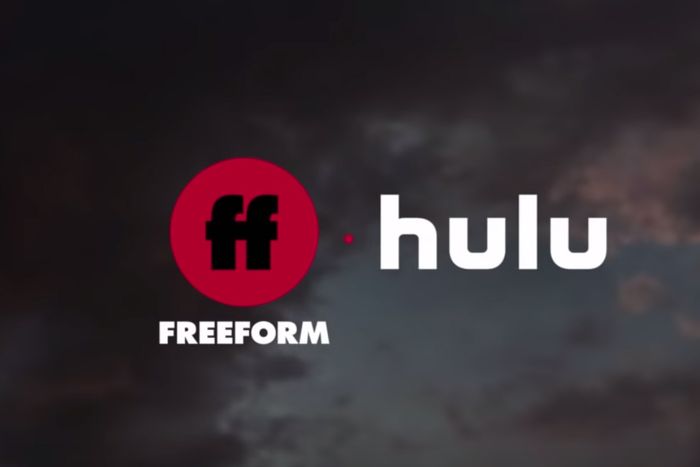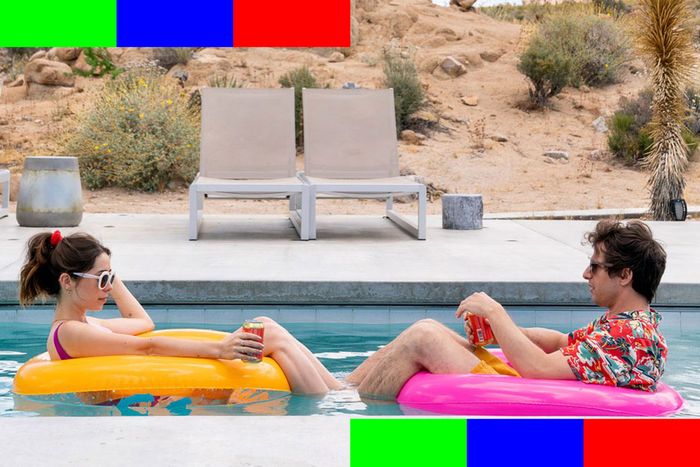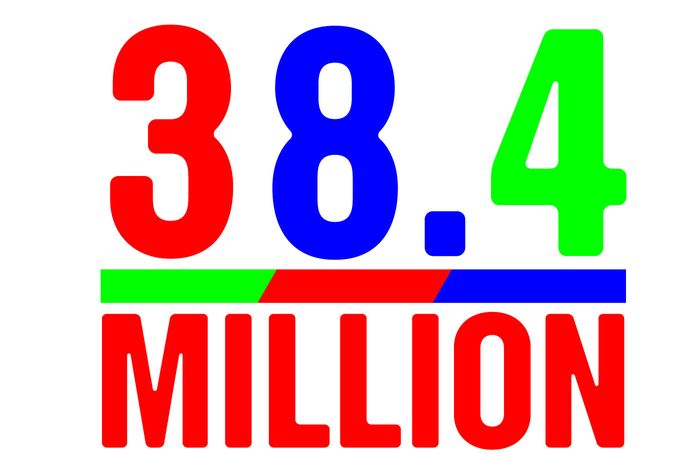
This article comes from Buffering, Vulture’s weekly newsletter about the streaming industry; you can sign up here for more.
Broadcast networks used to go to great lengths to avoid promoting even the existence of rival networks. Case in point: When Jay Leno and David Letterman first started hosting their respective 11:35 p.m. talk shows, they couldn’t tell viewers if a guest’s new sitcom was premiering that week on ABC or Fox. Nope, their show could be seen simply “on another channel.” Those restrictions eased by the time both men left the late-night battlefield, but networks are still reluctant to hype competitors. ABC, CBS, NBC, and Fox all ban promos from each other. And while they’ll take advertisements from cable channels and streaming platforms, they won’t let them advertise exactly when said shows premiere.
It’s all very silly, but as this week’s Buffering explores, traditional TV is starting to step out of its promotional bubble. Also in this edition: Which platforms are planning to join the Super Bowl ad wars, which Sundance films got snatched up by streamers, and the latest Disney+ series to hit a development roadblock.
Networks Cozy Up to Streamers
Last Sunday, Disney’s Freeform network ran an ad during CBS’s broadcast of the Grammy Awards to promote Motherland: Fort Salem, a new alternative-history thriller premiering this March. It was a compelling spot, filled with arresting visuals and a moody electronica soundtrack. But during the last frame of the ad, where networks usually flash a premiere date and their own logo, Freeform added something unexpected: a huge image of the Hulu logo.
Freeform’s logo is there, too, of course. Motherland was developed and produced entirely by Freeform; it’s not a co-production with Hulu, the way, for example, the Pop network co-produces Schitt’s Creek with Canada’s CBC. Despite that, odds are most of the people who watch it won’t see it on either the linear channel or Freeform’s own digital on-demand platforms. “On average, about two-thirds of our original series viewing is on Hulu,” Freeform marketing and branding chief Tricia Melton told me Wednesday.
Not long ago, most cable and broadcast execs would go to great lengths to hide such a stat. Today, smart suits like Melton are owning the reality of linear TV in 2020, and leaning into it.
• Starting this month, with Motherland and two other new 2020 shows (the Party of Five reboot and comedy Everything’s Gonna Be Okay), the network’s promos and print ads now give the Freeform and Hulu logos equal weight.
• Over at NBC, recent ads touting the season three premiere of Good Girls aren’t simply mentioning the fact past seasons are on Netflix (something the network has done before). They actively push the fact that season two just dropped on Netflix and feature the Netflix logo in a way that’s impossible to miss — the first-ever use of the actual Netflix logo in NBC advertising, the network confirms. Meanwhile, NBC’s current campaign promoting next month’s premiere of Zoey’s Extraordinary Playlist has for weeks been pushing audiences to stream the pilot on multiple platforms (including Hulu).
• FX has started aggressively advertising the March launch of “FX on Hulu,” a new partnership between the two Disney-owned properties under which select programming green-lit and developed by FX airs exclusively on Hulu, even as other FX titles stream episodes the next day.
In the case of Freeform, the move to use the Hulu logo as prominently as the network’s own marks an evolution of a strategy that Melton implemented not long after she arrived at the network in mid-2017. Then, the network began to include a small line of type underneath the Freeform logo indicating shows were available via app, on Hulu, and on demand. But as Freeform “continued to see our viewership on Hulu increase, we just made another strategic decision to simplify the message for consumers,” Melton says. The shows are still available on Freeform’s website and app, as well as via cable on demand. “But we have a millennial audience; they know that,” Melton explains. “It was very important to tell them specifically: Freeform and Hulu.”
Hulu’s new prominence in Freeform’s promos comes a few months after Disney took operational control of the streamer, making Hulu and Freeform sister companies. Melton says the shift in marketing messaging was the result of a natural “progression” that began two years ago, rather than the result of some push for corporate synergy. But she’s also not ruling out even further promotional alignment between the Freeform and Hulu brands. “We have a great relationship with the marketing team at Hulu, she says. “We work with them daily. So I think the opportunity for us to continue to experiment and to explore in this world is rich, yes.”
Expect more of this as linear networks evolve into hybrids. NBC’s decision to use the Netflix logo on air would’ve been unimaginable even two or three years ago. But as legacy media companies start rolling out platforms like Peacock and HBO Max (while ABC and Freeform will no doubt join FX in growing even closer to Hulu), they’re not going to worry all that much about brand confusion or “helping” another outlet. Even more serious concerns, like complaints from local affiliate station partners and cable providers, will matter less as networks look to hold on to viewers by any means necessary.
Melton told me something about the Freeform audience that I think applies to almost all audiences these days: “They want to be emotionally engaged with a series, and they want to know where they can watch it.” Linear networks fighting to stay relevant in the streaming era don’t have the luxury of worrying about much else.
TV Translation Trouble at Disney
Disney’s quest to turn its tentpole sci-fi brands into TV shows continues to hit snags. Late last week, Collider broke news that the Disney+ Star Wars spinoff Obi-Wan, already deep into the script-writing phase of production, was on indefinite hold; THR later confirmed, adding that the company was looking to replace writer Hossein Amini and that the show would now run four episodes instead of six.
THR’s Lesley Goldberg, meanwhile, reported on the latest additions to what’s become a long list of Marvel TV projects to have bitten the dust before getting off the ground. It seems animated adaptations of Howard the Duck and Tigra & Dazzler that had been planned for Hulu are now d-e-a-d. Per Goldberg, the cancellations are the result of Marvel movies overlord Kevin Feige taking control of the company’s TV unit and not because Hulu got cold feet.
These road bumps make for bad headlines, and in the case of Disney+, a slight delay in filling its still skinny original-programming pipeline with new content. Business-wise, however, these development glitches aren’t necessarily a big deal — and are in some ways a good thing. “The real disaster is when you realize something isn’t working but you’ve already cast the project and started pre-production,” one veteran TV producer who’s worked with Disney before told me. “If you’re going to have to retool it, now is the time you want to do it.”
What Else Is Happening
Streamers Blitz Sundance
Sundance is once again in full swing, serving two purposes for streamers.
The first is as a promotional platform to hype soon-to-release premieres, such as the Taylor Swift Netflix doc Miss Americana (out Friday) and Hillary, Hulu’s upcoming doc about Hillary Clinton (March 6), or the Disney+ movie Timmy Failure: Mistakes Were Made (Feb. 7.) It’s doubtful Sundance buzz translates to many extra eyeballs on projects, but the fest adds a layer of credibility and the splashy premieres certainly help with talent relations.
Sundance has also become a place for streamers to spend big on completed projects that they can quickly plop into their content pipelines. (Amazon, for instance, went wild last year.)
The biggest sale so far this year: The Andy Samberg–Cristin Milioti comedy Palm Springs, which will premiere on Hulu after a theatrical release via Neon. (Vulture caught up with the film’s cast this week.) Per a press release, Hulu and Neon teamed up to pay $17,500,000.69* for worldwide rights to the film (nice), apparently just enough to break the Sundance purchase price record set in 2016 by Birth of a Nation.
One reason Hulu may have stepped up to make this deal: Data. As the streamer noted in its release announcing the acquisition, Samberg is already a major presence on the platform via Brooklyn Nine-Nine, SNL reruns, and his cult classic Popstar: Never Stop Never Stopping. “With Palm Springs, Hulu will continue to super-serve the millions of young, highly engaged comedy fans on Hulu,” the release noted, using language only a Hollywood data nerd could love. But the tech-y chilliness of that sentence aside, it’s clear Hulu knows its users very much enjoy the Samberg/Lonely Island brand of comedy, enough to justify such a significant sum for a single movie.
*The email version of this newsletter mistaken listed this figure in the thousands, not the millions.
Amazon Prime’s Propaganda Problem
One of the most underrated features of Amazon’s Prime Video platform is the sheer tonnage of semi-obscure movies and TV shows you can find browsing its virtual shelves. Let Netflix and HBO Max fight over the rights to Friends: Prime Video is the home to oddball content such as Delta Burke’s unfortunate Designing Women spinoff Women of the House or dozens of episodes of Match Game ’78.
But what’s good for fans of Random Crap turns out to also be a boon for conspiracy theorists and kooks like Alex Jones. The Wall Street Journal details how a Prime Video feature which lets indie producers upload their movies and TV shows to the service has a very big loophole, one which exposes subscribers to all sorts of questionable content.
Shocking stat: The Journal found Prime Video boasts more than 65,000 separate titles, with two-thirds of them uploaded by users. By comparison, runner-up Netflix has just over 7,000 titles in its library.
Amazon has computer filters to make sure hardcore pornography doesn’t get uploaded to the site, and there are humans who take a look sometimes, too, the Journal reports. But what the paper found was that Prime Video is in some respects closer to YouTube than Netflix or Hulu in terms of how content gets distributed. The upside of this for subscribers — particularly fans of classic TV and movies — is that a whole bunch of stuff too “small” to merit a streamer striking a traditional licensing deal finds its way to audiences via Prime.
It would be a shame if Amazon reacted to the Journal story by cutting off access for smaller producers. A better solution: Tighten up guidelines for “factual” content and political documentaries so that Prime Video doesn’t continue spreading dangerous propaganda. Keep the “bad” TV; lose the bad ideas.
Contagion Goes Viral
As fears over China’s coronavirus mount, U.S. audiences appear to be taking another look at Steven Soderbergh’s chilling 2011 movie Contagion: Over the past few days, it’s surged into the top ten on the iTunes movie charts. THR points out that sales and rentals of the film are also being helped by the fact that the movie isn’t on any of the major subscription streaming platforms such as Netflix, Hulu, or Prime Video. But as Brett White over at Decider notes, the movie is on Cinemax, which you can order through a cable company or via an add-on through a live TV provider such as Hulu with Live TV.
Apple Keeps Mum
The company opted against using its quarterly earnings report Tuesday to release a ton of details about the performance of its new TV+ streaming service. While CEO Tim Cook gushed the platform was “off to a rousing start,” the company didn’t release any data about subscriber numbers or how many people its shows are reaching. He did tell Reuters that adoption of the new platform had been “very strong, both the people that are getting it in the bundle” — i.e., for free via purchase of a new device — “and the people that are paying for it that haven’t bought a new device.”
The low-key approach to the early months of Apple TV+ isn’t really a shocker. The company’s decision to hand out a free year of the service to anyone who bought a new iPhone made it clear Apple wasn’t looking to immediately make money off of selling new subscriptions, or to aggregate huge audiences the way Netflix does. As I noted last fall, Apple TV+ is about driving users into an Apple-branded television ecosystem and increasing the value and utility of its devices. Success won’t be measured in sign-ups.
Super Bowl Ads: Streaming Wars Edition
Sunday’s Super Bowl on Fox is the biggest marketing opportunity of the year for advertisers, but so far, only two streamers are planning a presence on game day.
• Prime Video this week released the one-minute Super Bowl spot for its upcoming original drama Hunters, which features Al Pacino tracking down Nazis in 1977 New York. It’ll be the third year in a row the company has advertised in the Superbowl: Hanna was hyped last year, and Jack Ryan was featured in 2018.
• Netflix isn’t saying anything official about game-day plans, but insiders tell Vulture the service is likely to have a 30-second spot run during the pregame buildup. It’s not expected to be an announcement of a new show or movie, like that one year Netflix decided to drop a surprise Cloverfield movie right after the game. THR this week reported Netflix is planning to pump up promotion of the service itself (instead of simply hyping individual titles), so perhaps its Super Bowl pregame ad will tout the virtues of a Netflix subscription.
As for other streamers, sources tell me Apple TV+ and HBO Max won’t be hyping their services on Sunday. Hulu hasn’t said a word about any Super Bowl plans, but it’s had a presence in the last three games, so it’d be more surprising if it didn’t show up. Peacock isn’t going national until July, when NBCUniversal will use the Olympics to push the platform, so I’d guess it’ll sit Sunday out.
Fun With Numbers
Per Nielsen, 38.4 million Americans chose to watch Sunday’s broadcast of the Grammy Awards on CBS, underscoring the continuing wide appeal of big awards shows among audiences. This number includes anyone who watched at least six minutes of the 200 minute-plus telecast; the full show had an average overall audience of 18.7 million viewers. The latter number is the one that was reported by most media outlets Monday and which will be recorded in the Nielsen record books. But with Netflix now leaning into data demonstrating which of its titles get picked by subscribers for a couple minutes (vs. watched from start to finish), it’s worth remembering broadcasters still have the ability to get a huge number of folks to watch something live.
The Time Capsule: Hulu Crashes the Super Bowl
While Fox is broadcasting Sunday’s Super Bowl from Miami, potentially millions of people will stream the game on various platforms — including Hulu, which will make the game available to subscribers of its Live TV tier (which carries Fox). It’s a big leap from 11 years ago, when the closest Hulu got to the American ritual was by purchasing an ad on NBC’s telecast of Super Bowl XLIII. That 2009 spot was actually Hulu’s first-ever national advertisement, debuting less than a year after the service became widely available. It featured Alec Baldwin pretending to be part of an alien conspiracy to melt human brains by overloading them with endless amounts of TV delivered via Hulu. Given the explosion in programming over the past decade, in retrospect, the ad seems more prescient than humorous.
Parting Shot
“It felt like a four-year conversation among a lot of really smart and funny people about what’s the best way to just approach the impossibility of being alive. And that was delightful.”
— The Good Place creator Mike Schur reflecting on his experience making the NBC show, which ends its run Thursday evening.




